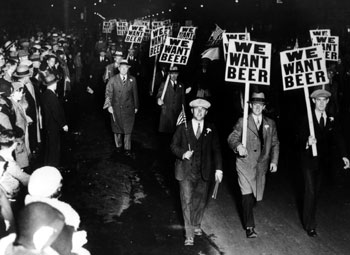
The History of Prohibition

“The phenomenon of Prohibition . . . is still non-understandable to the majority of a great, and so-called free, people. It is one of the most astonishing manifestations the world has ever witnessed.” This is how Charles Hanson Towne begins his book, The Rise and Fall of Prohibition, which was written in 1923. This seems to be a great paraphrase of how many Americans living during that time felt. This disbelief, anger, and unhappiness with the laws that attempted to prevent the consumption of alcohol in the United States is what would lead to the prevalence of many different forms of law-breaking, one of them being the smuggling of alcoholic beverages across the Mexican-American border.
On January 16, 1919 the Eighteenth amendment, which prohibited the importing,
exporting, transporting, manufacturing and selling of intoxicating liquors,
was put into affect. In October of the same year, the Volstead Act, also know
as the National Prohibition Act, became law. The Volstead Act defined an intoxicating
liquor as anything that had an alcohol content of more than 0.5 percent. This
law, in effect, made every beverage containing even the smallest amount of alcohol
illegal in the U.S. All of this, which was called by many as the “noble
experiment,” was done to greatly decrease alcohol consumption and decrease
alcohol related crimes. What happened in fact, was the opposite. During Prohibition’s
fourteen year span alcohol consumption actually went up, organized crime became
much more powerful, and drunken driving increased. It was clear that American’s
were unwilling to live under such a law, and it was finally abolished on February
17, 1933 by the Blaine Act.
Prohibition and the American public’s refusal to comply with it, lead to
heavy smuggling of alcoholic substances from Mexico into Texas. These smugglers
were pretty much protected by the communities that were affected by their crimes,
because these communities wanted alcohol and therefore supported their actions.
But alcohol wasn’t the only substance being smuggled over the border during
Prohibition. Due to the increased price of alcohol during this period, the smuggling
of marijuana and other illegal drugs from Mexico, which is a problem that we
still deal with today, became quite lucrative. For this reason, the end of Prohibition
did not put an end to the smuggling that took and continues to take place from
Mexico to Texas.
http://www.geocities.com/Athens/Troy/4399/
http://en.wikipedia.org/wiki/Prohibition
http://www.druglibrary.org/schaffer/Library/studies/cu/cu55.html
Towne, Charles Hanson. The Rise and Fall of Prohibition. 1923. The Macmillan
Company. New York